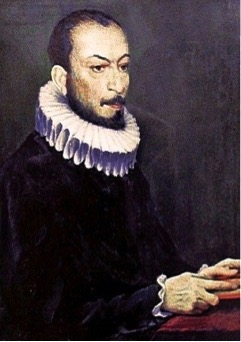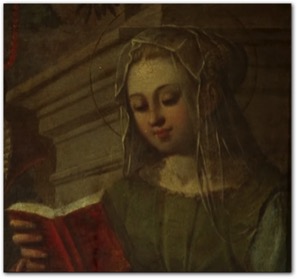Posted October 23rd, 2014 at 12:00 amNo Comments Yet

The life of Carlo Gesualdo, Prince of Venosa: a chronology
John La Bouchardière, October 2014
1566 Carlo Gesualdo is born, the second son to Don Fabrizio Gesualdo, part of a long line of nobility reaching back to the C11th Norman conquest of southern Italy. According to recent evaluation of witness statements, some form of fundamental neglect and possible abuse may have taken place during his early childhood.
From a young age, Carlo showed an interest in music and became a skilful lutenist. Strong family links with the Church would almost certainly have destined him for the priesthood, where he could happily have pursued his talent.
1584 Carlo’s grandfather, Prince Luigi Gesualdo of Venosa dies, leaving Fabrizio Gesualdo to inherit the title, with Carlo’s brother next in line.
1585 Carlo’s brother (also called Luigi) dies, making Carlo the heir. His life changes course completely at this point: he needs to marry, produce sons and accept the responsibilities of the title and a public role in society.
1586 Carlo marries his first cousin, Maria d’Avalos, daughter of the Marquis of Pescara. Already a widow who had borne children, papal dispensation was required to permit the marriage within a year of her last husband’s death. Reputedly, she was exceptionally beautiful and sexually voracious (one husband having died of an “excess of connubial blissâ€). The couple takes residence in Naples.
 1587 The marriage produces a son and heir, Emmanuele Gesualdo.
1587 The marriage produces a son and heir, Emmanuele Gesualdo.
1588 Maria begins an affair with Fabrizio Carafa, Duke of Andria, reported to be the most handsome man around. The House of Carafa was an important Neapolitan family that had included Pope Paul IV.
1590 Giulio Gesualdo, Carlo’s paternal uncle, attempts to seduce Maria but is rejected. He discovers her affair with the Duke of Andria and informs Carlo, who then sets a trap for his wife and her lover. Carlo and his servants find them in her bedroom and kill both of them, brutally.
Carlo immediately seeks advice from the Viceroy: he leaves Naples and returns to Gesualdo. A court finds that the killings were justifiable. Literary and often embellished versions of the events abound, invariably siding with the dead lovers over the husband. Carlo becomes a recluse.
1591 Carlo has a monastery built at Gesualdo, including a chapel entitled S. Maria delle Grazie.
1592 Carlo commissions a painting, which still hangs in the Maria Chapel, depicting his prostrate self pleading for absolution, accompanied by the late Cardinal Borromeo, his maternal uncle.
In Ferrara, where the Este court was among the most brilliant in Europe and legendary in its sponsorship of the arts, Duke Alfonso II is without a male heir. He therefore fears that his wealthy fiefdom will be claimed by the Papal States on his death, according to law.
1591 Cardinal Alfonso Gesualdo (another uncle) is instrumental in the Vatican’s rejection of the Duke of Este’s pleas to continue succession through a less direct line of descent.
1592 ‘Coincidentally’, a union is agreed between Duke Alfonso’s niece and the Cardinal’s nephew: Leonora d’Este and Carlo Gesualdo. Leonora’s great-great-grandmother was Lucrezia Borgia.
1593 Carlo takes a mistress at Gesualdo.
1594 Carlo travels to Ferrara for the wedding. After spectacular celebrations, Carlo remains in Ferrara with his new wife for most of the next two years. During this time, Carlo greatly enjoyed the cultural and musical feasts that Ferrara had to offer, meeting with many important and influential artists, including Tasso and Luzzaschi.
Carlo publishes his first books of madrigals. Thought to have been written during the preceding years, in Naples, they are unadventurous.
Leonora and Carlo’s son, Alfonsino is born. Carlo is not faithful to his wife. He beats her.
1596 Carlo returns to Gesualdo without Lenora. His journey takes him via Venice, where he is unimpressed by the Gabrielis.
Influenced by his experience in Ferrara, Carlo publishes two books of more experimental madrigals.
1597 Duke Alfonso dies. Carlo does not travel for the funeral. The now vacant fiefdom of Ferrara is forfeited to the Church. The d’Este family relocates to its remaining duchy, Modena. Leonora and Alfonsino travel to Gesualdo.
1600 Alfonsino dies. Emmanuele is now the sole male heir.
Leonora remains reliant on her brothers for consolation and support. She suffers increasing psychological and physical abuse. Carlo’s mistress bears him an illegitimate son.
1603 Carlo publishes two books of Sacrarum cantionum. Advanced for its type, the sacred music is more lyrical and less shocking than his secular writing.
Carlo’s two mistresses are found guilty of witchcraft (poisoning him by feeding him with menstrual blood). They are sentenced to death but Carlo intervenes, and they are kept imprisoned in his castle(…)
1607 Emmanuele marries Maria Polissena.
Leonora travels to Modena for a family wedding. Carlo repeatedly begs her to come home.
1608 Carlo orders Leonora back to Gesualdo. She writes of herself as a “willing martyr†as she returns to her needy but abusive husband.
1609 Carlo agrees that Leonora may visit Modena to recover her health. Her brother, Cardinal Alessandro, obtains a papal dispensation for a divorce, on grounds of maltreatment. Leonora does not proceed.
1610 Leonora returns to Gesualdo to care for her husband. Uncle Borromeo is canonised: Carlo tries to obtain his skeletal remains in hope of finding a cure for his illnesses. He submits to regular flagellation.
1611 Carlo pubishes his penitent, musically advanced Tenebrae Responses, and his last madrigals.
1613 Emmanuele dies, leaving his wife, Maria, pregnant.
Carlo dies, aged 47.
Maria gives birth to a girl, leaving no male heir to the estate. In accordance with Carlo’s will Leonora remains in Gesualdo for two years, carrying out his attempts to ensure his salvation and, in vain, to maintain the Gesualdo dynasty, which ends after six centuries of rule.
1615 Leonora travels to Modena.
1631 Leonora enters a convent.
1637 Leonora dies, aged 76.